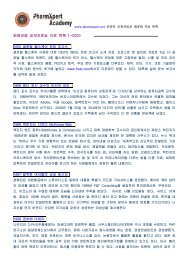PATIENT COMPLIANCE - PharmXpert Academy
PATIENT COMPLIANCE - PharmXpert Academy
PATIENT COMPLIANCE - PharmXpert Academy
You also want an ePaper? Increase the reach of your titles
YUMPU automatically turns print PDFs into web optimized ePapers that Google loves.
Behaviour ProgrammesFor an individual, neither agency nor emotion levels areimmutable. Yet, there are a number of studies that reportnegative emotions, especially depression and anxiety, to becommon in chronic disease and lead to low levels of patientcompliance with self-care behaviours. Therefore, our approachto patients with negative emotions could take priority overagency until the negative emotions have been addressed.After addressing emotion, the healthcare professional canbegin to address low agency; that is, infrequently engagingin self-care behaviours. The healthcare professional canapproach persons with internal control, but low agency, bysuggesting that they decide on their own what small stepsthey would take to increase self-care behaviours. For thosewith low agency and external control, the approach wouldbe for the healthcare provider to suggest a specific smallstep toward enhancing the ability and confidence of theindividual with each step.Our next step in the development of the CoMacDescriptor was to compare the results generated by theCoMac Descriptor with the impressions of a clinicianactively engaged in the care of the patients being studied.In order to accomplish this we engaged the collaborationof a nurse practitioner caring for the patients with type2 diabetes in our validation studies. She had extensiveexperience with these individuals and knowledge of theirself-care behaviours. We familiarised the nurse practitionerwith the domains being studied and how she might recognisethem. Of the 16 patients with diabetes, there was completeconcordance between the nurse practitioner’s classificationof the patients and that derived from the CoMac Descriptorin all but three cases. Of the three in which there was notconcordance, one did not complete the questionnaire and onewas clearly gaming the questionnaire. This study, therefore,assured us that we were dealing with a questionnaire thatyielded clinically meaningful and actionable information. Ournext developmental step addressed the generalisability ofthe linguistic approach that we had developed. Specifically:would a modification of the CoMac Descriptor directedat hypertension yield comparable results to those seen indiabetes and would such a modification for hypertension ina different culture or language yield comparable results tothose seen with the questionnaire in English?To address these questions we administered a modifiedCoMac Descriptor focused on self-care behaviours inhypertension to over 358 persons with hypertension inEnglish, Spanish, German, and Italian. We then comparedresults to a widely used questionnaire to predict compliance,the MARS-5. Our a priori hypotheses were that those subjectswho were internally oriented, and had high agency andpositive emotions would be the most compliant, and thatthose who were externally oriented, and had low agencyand negative emotions would be the least compliant. Thedata generated in this study supported these hypotheses 11 .Further, we were able to detect differences in the clusteringresults obtained in different populations with different nativelanguages. While we will need further study to characterisecompletely intercultural and inter-linguistic issues in ourapproach, we believe the data generated thus far support ourcontention that a linguistic approach to predicting self-carebehaviours is both reliable and generalisable.We believe that our linguistic approach yields informationthat both predicts self-care behaviour and provides avenuesor approaches to improve self-care behaviours when suchimprovement is necessary. First let us begin with twoquestions: “Does the CoMac Descriptor yield informationthat predicts compliance to self-care behaviour as well ascurrent questionnaires?” and “Does the CoMac Descriptoryield information that is more useful and actionable thanthat provided by current questionnaires?” Table 2 summarisesthe most common variables used to predict adherence toself-care behaviours. They are demographic and medical/epidemiological in nature.Table 2: Conventional explanatory variables and descriptive statisticsAge, mean = 52, S.D. = 12Demographic variables• Employed: 54%• Any college education: 48%• Stopped medicine because I got better: 11%Medical variables• Cost of the medication: 6%• Avoiding side effects: 10%• Had severe side effects: 8%• Medication not effective: 2%Data provided by Quintiles/MediGuardWhile demographic and medical information is interesting,it is not really useful to the clinician as the variables are notmutable. Table 3 shows the significant variables generatedfrom the study discussed in the previous paragraph. Whilethey give the clinician direction on how he or she mightchange the regimen, if that seems clinically appropriate,they are not particularly useful in developing an educationalapproach for the individual patient. The table also showsthat the significant variables predicted somewhat over 65%of the variation.Table 3: Results for all demographic and medical variablesCorrectly classified into an adherence category: 65.24%Significant variables• Had severe side effects• Avoiding side effects• Employed• Stopped medicine because I got betterData provided by Quintiles/MediGuardTable 4 summarises the results from the CoMac Descriptorin the same study. Predictability of compliance was slightlybetter than for the demographic and medical variables. Moreimportantly, as discussed above, the information providesuseful information that the healthcare provider can use in hisor her approach to the patient.Table 4: Results for the linguistic clusters in predicting adherenceCorrectly classified when using only linguistic variables: 66.86%Correctly classified when using all medical, demographic and linguisticvariables: 70.37%Data provided by Quintiles/MediGuardWe conclude that patients see the world differently andthose differences are important both in predicting behaviourand in changing it. For addressing adherence, knowing howpatients think is more important than their demographicsor attitudes toward their medical regimen. The CoMacwww.JforPC.comJournal For Patient Compliance Strategies to enhance Adherence and Health Outcomes 21
















